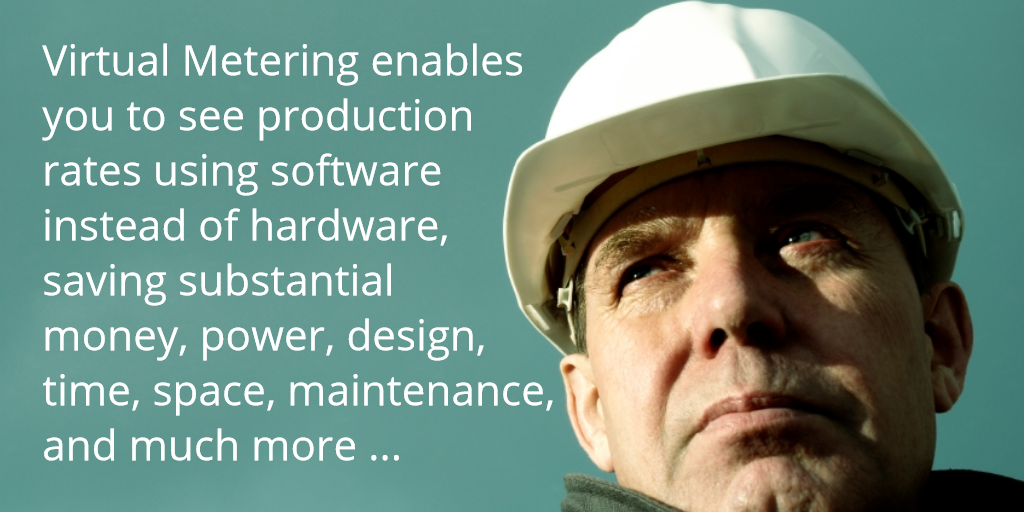What Is Virtual Flow Metering?
All engineers know what a meter is. It measures flow, but what is a “virtual” meter?
A virtual flow meter is a mathematical model that uses process conditions to estimate flow rates instead of using a physical meter. Virtual flow metering is a special case of a broader class; “Virtual Sensors”. In order to create and calibrate a virtual flow meter you do indeed need flow but only for a while. Once calibrated, the virtual flow meter can then just use process conditions to make its estimates.

In the case of oil and gas production, the physical meters are either on production separators measuring conjoined flow from many wells at the same time, or on test separators that measure flow for individual wells only occasionally and temporarily. During this “on-test” time we have well operating conditions and production for that particular well. This data is used to calibrate theoretical and/or data-driven non-linear regression models. Once the cause and effect relations are captured the model can be put on-line using the current well operating conditions. The model then outputs production estimates in real time. In this way, the asset team can see production from each well even when not on test.
Why Use Virtual Flow Meters?
Physical multiphase meters that measure oil, gas and water are very expensive, more so if they are good for accounting purposes. They are also expensive to install. In the case of off-shore platforms they have to be “barged out” or air-lifted to the platforms. Also, there may not be space to put a multiphase flow meter into the tangled maze of pipes. Physical meters also need to be maintained, subject to corrosion, sand, plugging with wax, methyl hydrates, etc. which can be costly as well. If you wish to have such meters on each well, and considering there are typically 5-15 wells on each platform, the cost is prohibitive and causes the asset team to make “educated guesses” about how much a well produces. On the other hand, virtual flow meters are software, much more affordable, and much easier to create and deploy.
In Brief
- Virtual flow Meters estimate flow using models created from data of process conditions vs. rates.
- The models are put on-line, converting process conditions into rates.
- Virtual flow meters are more affordable than real meters because they are software, not hardware.
- Our virtual flow meters re-calibrate automatically.
- Used by multiple major oil and gas companies.
Products Used
- Intellect Server
- Intellect Designer
- Intellect Expert
Autonomously Self-Maintaining Virtual Flow Meters
Yes, even virtual flow meters need to be maintained because the wells change and the reservoir depletes over time. In mathematics this is called a “non-stationary process”, a process that changes over time.
To maintain a virtual flow meter we use the occasional well tests to compare the rate given by the model vs. the rate given by the physical meter and make adjustments or re-field-fit the model. TO do this we automatically monitor for such a well test to occur, capture the data, compare it to the estimates (oil, gas and water production) and either adapt the models to reduce their error or if the error is large, remodel with the new data and perhaps some of the recent past tests. This all runs “autonomously” (automatically, unattended). We also have the platform meters that measure the sum of all the operating wells. We can compare the sum of the virtual flow meter estimates to the sum of production meters from time to time and adapt the individual wells’ estimates using a variety of sly algorithms. Sly? Yes, because you do not want to over-adapt to the platform meters as it may cause a loss of “intuitiveness” of the individual production estimates. This too is autonomous.
Benefits
Virtual flow meters offer a variety of benefits, some of which are mentioned above:
- The engineers and asset managers can see the production from individual wells, all three phases, between tests, continuously.
- Spending on expensive meters is reduced, eliminated for individual wells.
- Software is cheaper than multiphase flow meters, for procurement and installation and for on-going maintenance.
- Our virtual flow meters are self-calibrating.
- If sufficiently accurate, virtual flow meters can be used for allocation (how much oil and gas came from which well and zone, owned by different parties).
Many of these are cost avoidance or “soft” benefits but are valued by our customers.
